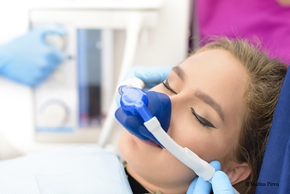Conscious sedation
 For the little patients who are afraid of the dentist or adult patients who are a bit anxious, we have a sedative equipment with NITROUS OXIDE, commonly known as laughing gas, that allows a conscious sedation.
For the little patients who are afraid of the dentist or adult patients who are a bit anxious, we have a sedative equipment with NITROUS OXIDE, commonly known as laughing gas, that allows a conscious sedation.
The fear of pain when going to the dentist is very common and makes a possible pain sensation even less tolerable.
Fear of the dental treatment often leads to its postponement, thus aggravating health, and leading to the situation in which the person in question must deal with it urgently, which requires more complex and expensive treatments.
What is Conscious Sedation?
Conscious sedation is a safe and stable anaesthesia technique that allows performing the dental treatment without feeling pain, anxiety, fear and stress. It is a very simple, non-invasive technique, which is therefore suitable for all people: elderly, adults, children altogether. It can be used in any kind of treatment: caries treatment, prostheses, root canal treatments, extractions, gingival treatment, implants. Conscious sedation desensitizes the mucous membranes of the mouth, thus reducing sensitivity and sensation of pain, favouring a state of well-being and tranquillity.
How does it work?
Through a nasal mask, the patient inhales a mixture of air, oxygen and nitrous oxide administered in a percentage personalized to each patient. After just a few inhalations, the relaxing effect starts to settle in, while the patient remains conscious and vigilant. At the end of the session, pure oxygen is administered for a few minutes, after which the patient is immediately able to leave the clinic alone and drive. Conscious sedation with nitrous oxide is an absolutely safe method as it is not toxic, is not metabolised by the body, is completely eliminated by breathing and does not cause allergies.
Who is it suitable for?
As there are no contraindications, conscious sedation is appropriate for all patients who are afraid of dental treatment. However, it is not recommended only for the following categories of patients: women in the first three months of pregnancy, drug addicts, persons taking antidepressants, those suffering from pulmonary infections, serious degenerative mental illness.
How is conscious sedation with nitrogen protoxide safe?
Nitrous oxide is a gaseous substance that has the following characteristics:
• Is inert
• Is not toxic
• There is no allergy to protoxide
• Is not metabolised by the body
• Has a reduced anaesthetic power (MAC 101%)
• Has no contraindications
• Does not alter defence reflexes, such as swallowing and coughing, which are always present
Advantages of conscious sedation
As the patient is relaxed, they actively collaborate with the dentist, thus significantly reducing the time needed for the dental treatment. Especially in the case of fixed-teeth implants, a lot of time is saved and costs are reduced significantly.
Therefore, the amount of analgesics and antibiotics is reduced, as they are taken according to the minimum number of sessions.
Recovery in the days following dental and/or surgical treatment is much faster and less painful compared to the treatments made in several sessions.
The relaxation effect is almost immediate, as well as its disappearance at the end of the treatment.
Intravenous conscious sedation
Conscious sedation has been a real revolution in the field of anaesthesia, even through its partially hypnotic properties. Conscious sedation manages to eliminate the sensation of pain during the surgery, without the need for the patient to be completely asleep. This is probably what makes it the best anaesthetic solution. First of all because it acts psychologically on the patient, who knows they must be subjected to an intervention that can cause them pain.
This innovative type of sedation can bring the patient closer to medical practices, making them less invasive and painful, completely removing fear, which was somewhat justified, but which, with the new anaesthetic techniques, no longer finds its place. From this point of view, the progress made is really remarkable, and it is not impossible to find in ambulatories and medical practices relaxed and quiet children, waiting for their turn without crying (which is also great for their parents).
The procedure involves the use of various medicines, including benzodiazepines such as midazolam and diazepam; sedatives such as pentobarbital, and narcotic analgesics such as meperidine and morphine. Still in terms of intravenous sedation, the method most used by modern professionals is a mixture of benzodiazepine with one of the many narcotic analgesics.
Benzodiazepine has an immediate amnesic effect able to remove the fear of pain, while the analgesic gives a state of slight euphoria. The anaesthetic effect of this combination is estimated at 80-90% and remains active approximately 20-40 minutes after administration. For this reason, doctors and anaesthetists must always monitor the patient's sedation and condition as time passes. The patient's pulse, respiratory rate, heartbeat should always be under the strict control of the physician, in order to understand the condition of the patient very well. This stage of monitoring is very important during the intervention in which sedation is required, as well as the dose administered, which varies according to age, weight and response of patients.
Due to intravenous conscious sedation, many interventions have become safer and faster to perform, and collaboration with the patient results in a plus for this type of anaesthesia. Being able to operate in complete silence, knowing that the patient feels no pain, and at the same time being able to communicate with them, advising them, for example, how to open their mouth, where to hold their tongue, etc., can only ensure the doctor's best performance, thus making it easier to do their work.